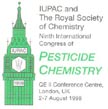
Chemistry International
Vol. 21, No.1, January 1999
1999, Vol. 21
No. 1 (January)
..Chemistry
in Africa
..News from IUPAC
..Other Societies
..Reports from Symposia
..Provisional Recommendations
..New Books
..Conference Announcements
..Conferences
CI
Homepage
Chemistry International
Vol. 21, No. 1
January 1999Reports from IUPAC Sponsored Symposia
9th IUPAC International Congress of Pesticide Chemistry, 2-7 August 1998, London, United Kingdom
The prestigious Queen Elizabeth II Conference Centre in London was the venue of the 9th IUPAC International Congress of Pesticide Chemistry. The Congress, sponsored by IUPAC and organized by the Royal Society of Chemistry, was attended by over 1,700 delegates from 58 countries worldwide.
Historically this Congress is held every 4 years and has previously been held in Israel, Finland, Switzerland, Japan, Canada, Germany, and during 1994 in Washington DC, USA.

Click here for a larger image (20K)The Congress theme for 1998 was "The Food and Environment Challenge", reflecting the problem of feeding the ever increasing world population in the next millennium while also meeting the high demands for environmental quality and a safe food supply. The Congress was opened on 2 August with a welcome from the Chairman of the Executive Committee, John Finney, and by Dr. Junshi Miyamoto, President of the IUPAC Division of Chemistry and the Environment. Dr. Miyamoto briefly explained the organisation and role of IUPAC and in particular the formation of the new Division of Chemistry and the Environment.
Professor Sir Colin Berry, in his lecture entitled "Caution, precaution, and indemnity", continued the theme of food and food safety, looking primarily at regulation. Professor Berry told the audience that the variety, quality, and quantity of food currently available has improved significantly over the last 40 years. He indicated that many problems in food production and preparation are microbiological, yet despite this reason it is the chemicals in food, many of which are added to prevent microbiological problems, that cause consumer anxiety and hence increase regulation. Professor Berry presented several examples highlighting how the pesticide industry is affected by health concerns that are in many cases illogical when compared to other normal household activities. In summing up, Professor Berry reminded the audience that regulation clearly does increase safety, but it does not in itself generate safety. All regulations should be formulated using a risk-benefit analysis.
Click here for a larger image (20K)
Dr. John Finney, Chairman of the Executive Committee
The Congress itself revolved around eight main topics representing all the phases of pesticides invention through registration. Each of the main topics comprised four or five plenary lectures supported by five related poster sessions each with an associated workshop. The main topics were:
- Synthesis and Structure Activity Relationships
- Delivery
- Natural Products
- Mode of Action
- Metabolism
- Environmental Fate
- Residues in Food and the Environment
- Regulation and Risk Assessment
Click here for a larger image (32K)
Dr. Junshi Miyamoto, President of the IUPAC Division of Chemistry and the EnvironmentThe plenary lectures were given by leading authorities in the individual subject areas and chosen to provide new insights and to provoke discussion that could be further taken up in the poster sessions and workshops.
Over 1,000 posters were presented at the Congress and, combined with subsequent workshops, provided a forum for scientific debate.
This event is a highlight in the Pesticide Chemistry diary, bringing together practitioners from a wide range of disciplines and facilitating both broad-based and specific discussions.
The next Congress, the 10th, will be held in Basel Switzerland in August 2002, and will be organized by the New Swiss Chemical Society and the Swiss Society of Chemical Industries. The theme of the Congress will be "Innovative Solutions for Healthy Crops".
M. Skidmore
Commission of Agrochemicals
and the Environment VI.4.
News
and Notices - Organizations and People
- Standing Committees
Divisions
- Projects - Reports
- Publications - Symposia
- AMP - Links
Page last modified 11 June, 1999.
Copyright © 1997, 98, 99 International Union of Pure and Applied
Chemistry.
Questions or comments about IUPAC, please
contact the Secretariat.
Questions regarding the website, please contact [email protected]


